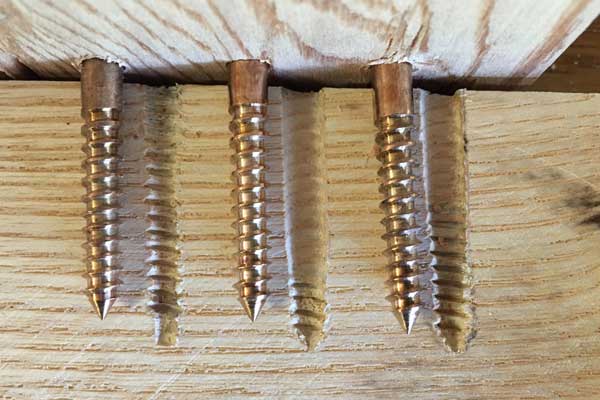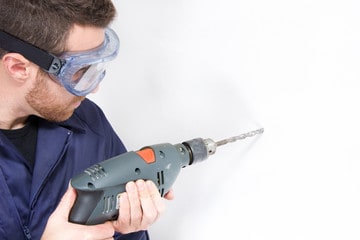Pilot hole, predrilled hole, and advanced borehole are the same terms for the same hole which is drilled on the material before starting the complete drilling process or driving the screws. Pilot holes are essential for a safe, accurate, efficient, low-force, and faster drilling process. When you drill a pilot hole, you have to use a special drill bit according to the workpiece material.
For the wood pilot hole, you can use a countersink drill bit, and for the metal, you can use a center drill bit and spotting hole drill bit successfully. The minimum depth for a wood pilot hole should be 1/4,” and for the metal, it can be 2 – 3 times of the used drill bit.
When you drill a pilot hole, you should pay attention to many sectors for safety, accuracy, and efficiency. So let’s keep reading on until the end with the proper guide for the drill pilot hole.
What is a Pilot Hole?
A pilot hole is a small hole drilled into a material, such as wood or metal, before driving a screw into it. The main purpose of a pilot hole is to guide the screw and prevent the material from splitting or cracking due to the pressure exerted by the screw. It also makes it easier to drive the screw straight into the material.
The size of the pilot hole is determined by the size of the screw. Generally, the pilot hole should be smaller than the diameter of the screw. This ensures that the screw threads can bite into the material and hold the screw firmly in place.
You should use a pilot hole drill bit to drill a pilot hole. The drill bit should be of the same diameter as the screw’s inner core (not including the threads). Drill bits come in various sizes to accommodate different screw sizes.
For harder materials like metal, pilot holes are particularly important. They not only make it easier to drive the screw, but also prevent the screw from getting stripped or the drill bit from breaking.
How Deep Should a Pilot Hole Be?
Pilot Hole depth is very important factor. According to the material, the pilot hole depth is varied. Normally, a deeper pilot hole is good for woodworking, and a shallow pilot hole is good for metalworking.
1. Pilot Hole Depth for Metal
The average depth of the pilot hole for metal is 2-3 times the used drill bits diameter for the drilling pilot holes. For the screws, you must use recommended pilot hole depth according to the nominal diameter of the metal.
In most cases, screw pilot holes are not prepared in metals. If there is a special design or case screws, pilot holes can be created in the metal.
2. Pilot Hole Depth for Wood
These are the pilot hole depth for the wood.
| Screw Size | Screw Length | Hole Depth |
| #2 | 1/2″ | 1/4″ |
| #3 | 5/8″ | 1/4″ |
| #4 | 3/4″ | 3/8″ |
| #5 | 3/4″ | 3/8″ |
| #6 | 1 1/2″ | 3/8″ |
| #7 | 1 1/2″ | 3/8″ |
| #8 | 2″ | 1/2″ |
| #9 | 2 1/4″ | 3/4″ |
| #10 | 2 1/4″ | 3/4″ |
| #12 | 2 1/2″ | 3/4″ |
| #14 | 2 3/4″ | 1″ |
What Will Happen When a Pilot Hole is Deeper and Wider?
When the pilot hole is deeper than its recommended depth it will not tight well with inner materials. The screw will be loosened and it can’t hold more force. You can pull it out easily.

What are the Recommended Drill Bit Sizes for Softwood and Hardwood Pilot Holes?
These are the recommended pilot hole sizes for softwood and hardwood
| Screw Size | Drill Bit Size for Soft Wood | Drill Bit Size For Hard Wood |
| #0 | 1/64 | 1/32 |
| #1 | 1/32 | 1/32 |
| #2 | 1/32 | 3/64 |
| #3 | 3/64 | 1/16 |
| #4 | 3/64 | 1/16 |
| #5 | 1/16 | 5/64 |
| #6 | 1/16 | 5/64 |
| #7 | 1/16 | 3/32 |
| #8 | 5/64 | 3/32 |
| #9 | 5/64 | 7/64 |
| #10 | 3/32 | 7/64 |
| #11 | 3/32 | 1/8 |
| #12 | 7/64 | 1/8 |
| #14 | 7/64 | 9/64 |
| #16 | 9/64 | 5/32 |
| #18 | 9/64 | 3/16 |
| #20 | 11/64 | 13/64 |
| #24 | 3/16 | 7/32 |
Soft Woods – Pine, Cedar, Redwood, Spruce, Douglas fir
Hard Wood – Oak, Maple, Hickory, Walnut, Cherry
The pilot hole size for steel is as below.
Steel Pilot Hole Sizes Download
How to Drill a Pilot Hole in Wood and Metal?
Drilling the Pilot hole will need a few steps. You can follow these steps to make the pilot hole in the wood and metals.
1. Select the drill bit.
- Wood pilot hole drill bit
Select the drill bit according to the diameter of the screw. You can check it with your screw size and select the appropriate drill bit sizes in inches using the above table. When you drill pilot hole in the wood, you can use a countersink drill bit successfully.
And also, for the metals, you can follow the same step.
- Metal pilot hole drill bit
When you need to drill a hole on the metal, you should have a pilot hole every time. Because the drill bit can wobble or slipper easily, and that affects the accuracy directly. Therefore you can use a center drill bit, spotting hole drill bit, as a pilot hole drill bits successfully.
2. Locate the point
The drilling location should be marked with a clear sign. You can use ink to mark the place. You can punch the exact point using the puncher.
3. Apply the cutting oils.
If you drill a pilot hole in the metals, you should apply the lubricants in order to reduce the drill bit by overheating and improving the cutting speed.
4. Start drilling.
You can start drilling slowly at the beginning and then increase the drilling speed slowly. Do not start high-speed drilling. The drill bit will move here and there due to the high-speed drilling, and it will not tap the exact place correctly.
5. Clean the hole
After you drill the pilot hole, you should clean the hole. If you use to drive screws through the pilot hole, it will need to apply more force. But if you drill that hole again, you do not need to clean it additionally.
How to Drill Pilot Hole Without a Drill Bit?
You can drill a pilot hole without a drill bit easily. You just need to use any type of nail without its head, or any small steel bar with one end in a chisel shape can use as a pilot drill bit for the wood. For the metals, you can use a puncher for that.
All these methods will create a small hole as the drill bit can hold tightly without moving here and there for the drilling purpose.
But for the screw drilling, you should have an equal diameter nail or steel bar for the screw-driving pilot hole preparation. If the hole is not enough for the shank diameter, the wood will be cracked easily. This can happen easily when you work on the edges.

